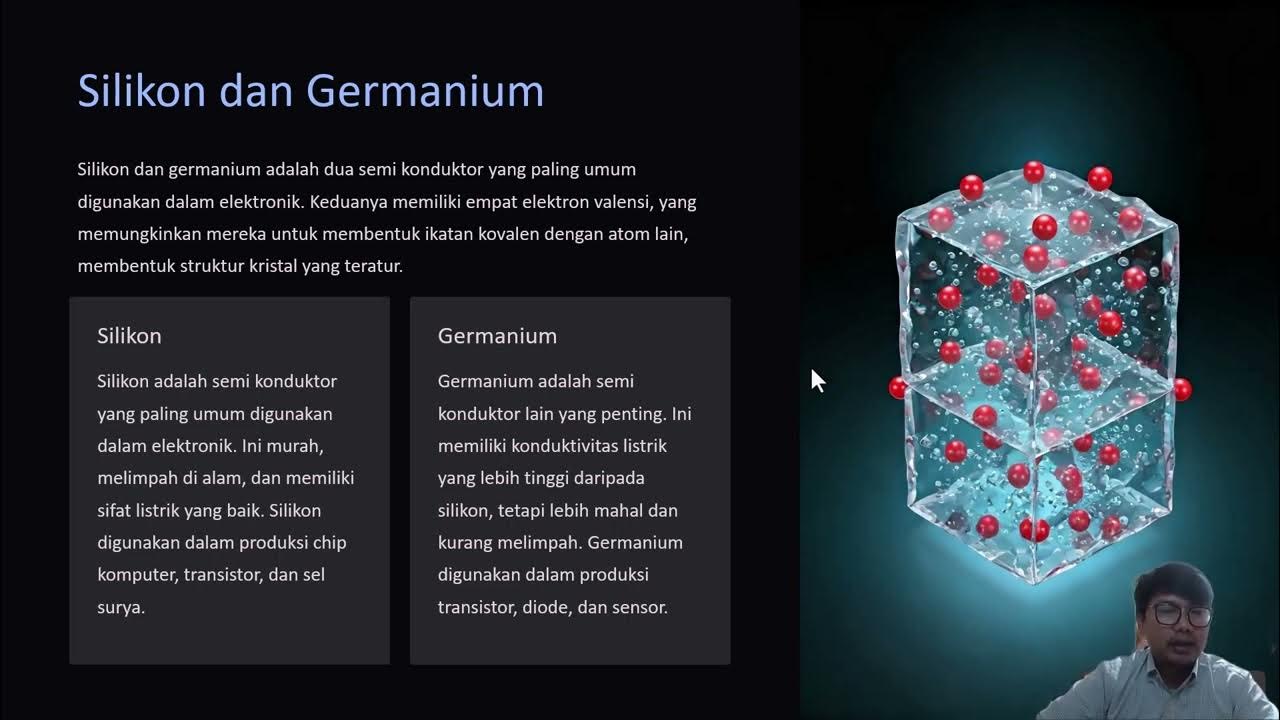Muddiest Points: Electronic Properties I
Summary
TLDRThis screencast explains the fundamental electronic properties of conductors, insulators, and semiconductors, focusing on their varying conductivity levels. The video delves into band structures, discussing how the arrangement of energy bands in metals, semiconductors, and insulators affects their ability to conduct electricity. It covers the roles of grain size, boundary area, and temperature in influencing conductivity. Key concepts like charge carrier density, electron and hole mobility, and their contributions to overall conductivity are also explained. The video concludes by contrasting the conductivity of metals, semiconductors, and insulators, highlighting the key factors responsible for their differences.
Takeaways
- 😀 Conductors, semiconductors, and insulators differ in conductivity due to their band structures and the way electrons behave in each material.
- 😀 Conductors (like metals) have a high conductivity due to the free movement of valence electrons in their band structure.
- 😀 Semiconductors have moderate conductivity, with a band gap that allows electrons to jump to the conduction band when energy is provided (e.g., through temperature).
- 😀 Insulators have a very low conductivity because their electrons cannot easily move to the conduction band due to a large energy gap.
- 😀 The conductivity of semiconductors can be affected by temperature, which provides thermal energy to create more electron-hole pairs.
- 😀 The mobility of electrons in semiconductors is typically higher than the mobility of electron holes, meaning that electrons contribute more to conductivity.
- 😀 Imperfections in materials (like grain boundaries, impurity atoms, and vacancies) reduce conductivity by scattering electrons.
- 😀 Cold working metals (e.g., copper) increases imperfections, reducing their conductivity compared to annealed metals with fewer imperfections.
- 😀 The charge carrier density for metals is much higher than that for semiconductors and insulators, contributing to their high conductivity.
- 😀 For semiconductors, both electrons and electron holes contribute to conductivity, with their respective mobilities affecting the overall conductivity.
- 😀 Insulators have very few free charge carriers due to their large energy gap, making their conductivity extremely low compared to metals and semiconductors.
Q & A
What are the three major classifications for the conductivity of electronic materials?
-The three major classifications for the conductivity of electronic materials are conductors, semiconductors, and insulators. Conductors generally consist of metals, semiconductors include materials like silicon or germanium, and insulators typically consist of ceramics and polymers.
Why do metals have higher conductivity compared to semiconductors and insulators?
-Metals have higher conductivity because all atoms contribute their valence electrons to the conduction band, resulting in a high charge carrier density. In contrast, semiconductors and insulators have fewer charge carriers due to larger energy gaps that restrict the flow of electrons.
How does the band structure of metals differ from that of semiconductors and insulators?
-In metals, the band structure can either have a half-full valence band or overlapping conduction and valence bands, allowing electrons to move freely. Semiconductors have a full valence band and an energy gap before the conduction band, with electron-hole pairs created by thermal energy. Insulators have a larger energy gap between the valence and conduction bands, making electron-hole pair formation more difficult.
What is the significance of the energy gap in semiconductors and insulators?
-The energy gap in semiconductors and insulators determines how easily electrons can move to the conduction band. Semiconductors have a moderate energy gap, allowing some electrons to jump into the conduction band with thermal energy. Insulators have a much larger gap, making it harder for electrons to move into the conduction band, which is why they have lower conductivity.
What factors affect the conductivity of metals?
-The conductivity of metals is affected by imperfections like grain boundaries, impurity atoms, dislocations, and vacancies. Fewer imperfections lead to less electron scattering and higher conductivity. Conductivity also increases when the temperature decreases, as smaller atomic vibrations reduce electron scattering.
How does temperature influence the conductivity of semiconductors and insulators?
-For semiconductors, increasing temperature provides more thermal energy, creating more electron-hole pairs and increasing conductivity. Similarly, for insulators, higher temperatures generate more electron-hole pairs, enhancing their conductivity. In both cases, temperature plays a crucial role in making the materials more conductive by facilitating the movement of charge carriers.
What is the relationship between electron mobility and conductivity in semiconductors?
-In semiconductors, electron mobility directly influences conductivity. Electrons move more easily in the conduction band, contributing more to conductivity. Since electron mobility is usually higher than hole mobility, the electron contribution to conductivity is greater than that of electron holes.
How do impurities and defects affect the conductivity of semiconductors?
-Impurities and defects in semiconductors create additional scattering sites for charge carriers, reducing mobility and overall conductivity. Lower grain boundary areas and fewer imperfections lead to improved conductivity in polycrystalline semiconductors.
How is the charge carrier density calculated for a conductor like silver?
-The charge carrier density for a conductor like silver is calculated by multiplying the number of atoms per cubic meter by the number of valence electrons per atom. Using the density of silver and its molar mass, we can determine the number of silver atoms in a cubic meter and then calculate the charge carrier density.
What is the difference in conductivity between metals, semiconductors, and insulators?
-Metals have high conductivity due to a high carrier density and free-moving electrons. Semiconductors have moderate conductivity, as only a small fraction of atoms can contribute electron-hole pairs. Insulators have very low conductivity, with an even smaller carrier density and a large energy gap, making it harder for charge carriers to contribute to conductivity.
Outlines

このセクションは有料ユーザー限定です。 アクセスするには、アップグレードをお願いします。
今すぐアップグレードMindmap

このセクションは有料ユーザー限定です。 アクセスするには、アップグレードをお願いします。
今すぐアップグレードKeywords

このセクションは有料ユーザー限定です。 アクセスするには、アップグレードをお願いします。
今すぐアップグレードHighlights

このセクションは有料ユーザー限定です。 アクセスするには、アップグレードをお願いします。
今すぐアップグレードTranscripts

このセクションは有料ユーザー限定です。 アクセスするには、アップグレードをお願いします。
今すぐアップグレード5.0 / 5 (0 votes)






